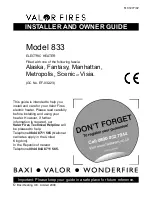
14
Servicing should only be performed by a Qualified Service Technician
TROUBLESHOOTING CHECKLIST
COMPLAINT
CAUSE
REMEDY
USER
QUALIFIED SERVICE AGENCY
Water not hot enough.
Thermostat set too low.
Set thermostat dial to a higher
temperature.
Upper and/or lower temperature
probe out of calibration.
Call qualified service agency.
Check continuity and resistance
(Ohms) of upper and lower
thermostat probes. Replace probes
if out of specification.
Insufficient hot water
Thermostat set too low.
Set thermostat dial to a higher
temperature.
Upper and/or lower temperature
probe out of calibration.
Call qualified service agency.
Check continuity and resistance
(Ohms) of upper and lower
thermostat probes. Replace probes
if out of specification.
Main manual gas shutoff valve
partially closed.
Open main manual gas shutoff
valve to fullest extent.
Heater too small for demand.
Space usage to give heater time
to restore water temperature.
Heater recovery is slower.
Call qualified service agency.
Check gas input. If incorrect, adjust
gas pressure or replace main burner
orifice.
Draft hood not installed or one
or more baffles.
Call qualified service agency.
Install draft hood or baffles as
furnished with unit.
Water temperature too hot.
Thermostat set too high.
Set thermostat to a lower setting.
Heater makes sounds: sizzling.
Condensation on outside of
tank - normal.
Rumbling.
Sediment accumulation on
bottom of tank.
Drain a quantity of water through
drain valve. If rumbling persists,
call a qualified service agency.
Delime heater.
Ticking or metallic sounds.
Expansion and contraction-
normal.
Pounding / water hammer.
Air chambers in piping have
become waterlogged. Thermal
expansion tank damaged,
improperly charged, or
improperly sized.
Drain piping system and refill.
Heater must be off while this
is being done. Check thermal
expansion tank charge pressure
when the water system pressure
is zero.
Follow the manufacturer's
instructions for proper charging
of the thermal expansion tank.
Combustion noises.
Too much primary air.
Adjust shutters.
Overfired heater. Incorrect
burners or orifice for types of
gas used.
Call qualified service agency.
Check and correct as necessary.
Water leaks.
Drain valve not closed tightly.
If drain valve cannot be closed
tightly, replace.
If leakage source cannot be
corrected or identified, call
qualified service agency.
Shut off gas supply to heater
and close cold water inlet valve to
heater.
Repair or in case of suspected tank
leakage, be certain to confirm before
replacing heater.
Gas odors.
Heater is overfired.
Shut off gas supply to heater and
call qualified service agency.
Check for sooted flue passage.
Check for obstructed vent line.
Check backdraft or lack of draft.
Draft hood may be improperly
installed or not sized properly.
Possible gas leaks.
Shut off gas supply to heater and
call gas company at once.
















































